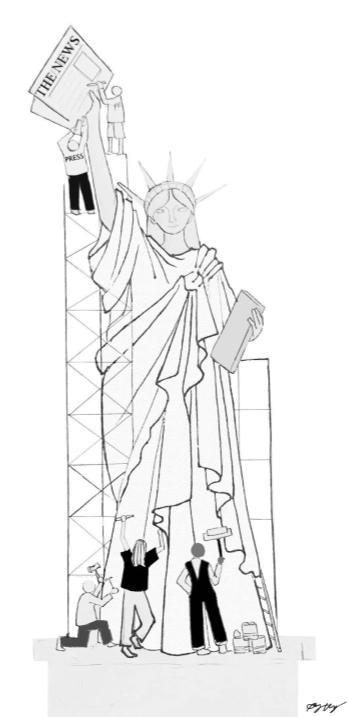Opinion: News consumers have responsibility to discern misinformation from truth in media
November 19, 2020

Whenever we access the Internet, we inevitably come across lies. Lies when we scroll through reposted tabloids that permeate Instagram stories, lies all over Twitter, lies on Facebook ads. When we explore any form of social media, we’re bound to find these lies in one form or another—whether it’s false facts, ads disguised as news, or conspiracy theories.
We often ridicule these things when we see them—that is, we may chuckle at the thought, and scroll past the triviality of the falsehood. We can usually—but not always—recognize fabricated news when we see it.
But with increased usage of the Internet to spread misinformation, and especially as a result of the soon-to-be-former President Trump declaring the free press as “an enemy of the people,” there has been a greater load of manufactured “facts” that infect our daily consumption of “news.” Among these fabricated news headlines, decontextualized pictures and fake statistics, criticisms of the mainstream media are common—we’ve all seen posts that go something like this:
“(Name/Group) (violent verb) (frightening statistic). Why hasn’t the media reported on this?”
Probably because it’s simply not true. False headlines like these often use fabricated pictures or take existing ones out of context to make up a story.
These posts foster greater mistrust towards journalists in general—spinning the narrative that the media ignores information that could dishonor its supposed radical-left or far-right representatives in some kind of authoritarian, press-manipulating regime.
These criticisms of mainstream media may be baseless, but aren’t exactly unreasonable. According to an article from the Columbia Journalism Review (CJR), mainstream media today, compared to 60 or 70 years ago, places less emphasis on the objective facts of news, and focuses more on an interpretation of the information—the why. Straight, solid objectivity in mainstream media of the past proved to be ineffective when journalists were given complete lies, especially those from past US presidents such as Eisenhower, Kennedy, and famously, Nixon, according to CJR. This led to a reduced emphasis on objective reporting, and an increased emphasis on analysis of the information presented. This leaves us, the consumers of mainstream media, the responsibility to distinguish for ourselves what the facts are versus the media’s judgment.
Columnist for the Washington Post Margaret Sullivan suggests that mainstream media can build more trust by being transparent about their biases up-front. By being more open with their reporting processes, Sullivan says, journalism organizations can be more clear with their readers and viewers about where the information they publish comes from. Along with this, according to a report from the Pew Research Center, three out of four Americans want journalists to call out “falsehoods” clearly. In other words, when the mainstream media comes across complete lies, they have to call it out rather than falling victim to neutrality bias—when the press is so focused on being unbiased and equal in their reporting on a controversial topic that they give unfounded credit to a perspective that is objectively less credible. When cable news features a debate with scientists and others on the existence of climate change, even though there is already a scientific consensus on the topic, it puts an already decidedly true statement up for dispute unnecessarily.
But while we may call on the media to clearly point out when something isn’t true, it’s not effective unless we, the people, do something about it too. When we see clear, unadulterated falsehoods, we can’t simply move on, or worse, repost it. As residents in a nation that prides itself on its democracy, we have to be more active in maintaining it. In a way, our ability to repost and share news through the Internet makes us all journalists. And as journalists who are privileged to live in a nation with the freedom of the press, we have to do what we keep telling the mainstream media to do. We have to do more to recognize when something is false, and call it out. Trump is yelling about voter fraud again? A quick Google search and analyzing fact-based news sources such as the Associated Press or Reuters will tell you that’s a baseless accusation. When a conspiracy surfaces that accuses Wayfair of involvement in a worldwide sex-trafficking ring, we can confirm with numerous fact-checkers that it simply lacks substantive evidence and in all likelihood is not true.
As former president Barack Obama put it, “It’s very hard for our democracy to function if we are operating on just completely different sets of facts.” In order to work with mainstream media on reporting and publishing reliable information, we ourselves have to be able to recognize what is and what isn’t true.
Organizations like the News Literacy Project have surfaced to help educators teach “the abilities needed to be smart, active consumers of news.” According to a report from the Pew Research center, only 26% of U.S. adults could correctly classify five out of five factual statements as factual. Another report from the Stanford History Education Group revealed that 96% of high school students surveyed failed to challenge the credibility of an unreliable source.
We, as young people who will soon gain or already have voting rights, and who represent the future of our nation, can’t let lies and fake facts slide on social media platforms that we dominate. We can’t be part of the disease of misinformation. To rebuild not only the accuracy of the media we consume, but also to help heal our divided nation, we have to be able to distinguish fact from fiction. We can’t keep tolerating nonsense in place of real information.


